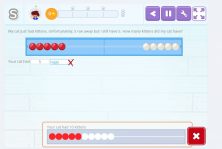What is feedback
We understand feedback as the answers and comments given to students after they finish a task or activity. Through this feedback, students receive information that creates an idea or belief in respect to their results.
For this feedback to be more effective, it should be given immediately after the task is completed. The immediate feedback makes learning more meaningful. In this way, the results are more efficient, because the mistakes and false beliefs of the students can be corrected more quickly, right at the moment when they are presented with the challenge.
The feedback can be internal, if it comes from each individual according to their perception of their results, without being evaluated by anyone else. External feedback, on the other hand, comes from other people like teachers or parents. In order to achieve self-regulation of learning, it is important that feedback becomes more and more internal.
Conditions needed for feedback to be effective:
- It has to be appropriate, adjusted to the task that the student is doing.
- Credible, realistic, and not exaggerated.
- Reoccurring, repeated each time the student carries out a task.
- An adequate amount, and carefully without any positive or negative intensifiers.
- Descriptive. Defining well what they have done and how they have done it without evaluations or prejudice.
- Proactive, which generates an action that favors repetition and avoids frustration.
- Easy to understand. Should be given in clear and concise language.
- Based on data: objective and real.
- Based on a work plan so that they can clearly see the phases or stages needed to achieve that learning.
- In various ways. There can be several ways to give feedback depending on whether it is classroom learning or online.
- In adjusted time. We know that immediate feedback is much more effective.
- It should encourage constant practice to consolidate learning.
Importance of immediate feedback in virtual learning environments
It is a key piece in guaranteeing that these environments are personalized. Immediate feedback and the possibility to correct any error at that moment is very effective when we do not have a teacher or tutor present.
It promotes autonomy and self-learning. It is the student who manages and corrects the moment a doubt arises, making the pace of learning more adaptable to each individual.
Feedback can be a very powerful motivator and promote personal goals to overcome the following tasks.
In summary, immediate feedback has the potential to help academic performance, promote motivation, self-regulation, and self-efficiency, allowing students to reduce the distance between their current performance and desired performance.
At Smartick we seek to give immediate feedback and complement it with positive reinforcement in order to avoid frustration with errors and early abandonment by children with a low tolerance of frustration. Additionally, the possibility to correct errors exists within the session and they can win ticks for doing so. These characteristics are especially important and useful for children with attention problems.

Learn More:
- The Importance of Positive Reinforcement in Education
- What Makes Smartick Different from Mathletics?
- The Importance of Respecting the Rhythm of Learning
- Learning by Playing Videogames
- Kumon vs Smartick: Similarities and Differences
- Master Math! 10 Reasons to Help Your Child do Just That - 05/28/2020
- Why Do Children Believe That Things Happen? - 05/25/2020
- Is Self-Control Linked to Health? - 05/19/2020








